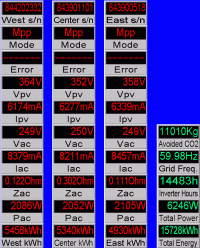|
After making the sizeable investment in my PV generating
plant, I wanted to assure maximum performance. So I collected the
necessary equipment and began taking measurements. Here's what is
needed to assess performance with reasonable accuracy:
|
|
|
First, some basic instruments, such as
Analog AC and DC voltmeters (oldies but goodies)
Digital AC and DC voltmeters
AC and DC clamp ammeters
Non-contact infrared thermometer
Calibrated silicon PV reference cell.
|
 |
|
Some information is gathered from five kilowatt-hour
meters. One, of course, is the utility company meter,
and the PV system is equipped with a private meter. A third meter is
dedicated to our electric domestic water heater, another for the heat
pump, and finally one for our EV charger.
|



|
|
Data for evaluating the Xantrex inverters is
obtained from their displays. The original model ST2500's displayed
instantaneous power output and total energy delivered to the moment. The newer STXR2500's displayed only the total energy delivered.
|
|
|
Early in the project the Xantrex inverters were
replaced with SMA Sunny Boy inverters.
The Sunny Boys are equipped with
RS-485 datacom ports that convey a wealth of information. SMA provides a
free software product called Sunny
Data. It is Windows-based, easy to use, highly configurable, and quite powerful. For
those viewers who like to add numbers to check totals, be aware that the
individual inverter values (shown in red) will be totaled into the system
wide fields (shown in green) at the next sample interval. Green is always
one sample behind red. |

|
|
The RS-485 interface is accomplished with a
small conversion adaptor that connects to a COM port. I first used Sunny
Data under Windows 98 with an RTS-enabled RS-485 converter. It worked
well, but failed miserably when I upgraded to Windows XP. The scope
traces of the RS-232 signals show why.
This image shows the end of the outbound query packet issued by Sunny
Data. The traces were triggered by the de-assertion edge of RTS
(lower trace) which disables the RS-485 line drivers. The final 26
milliseconds (including stop bit) of the query packet was not delivered so
of course no inverters replied.
I replaced the RTS-enabled converter with a self-enabled
model and the problem was solved.
|
 |